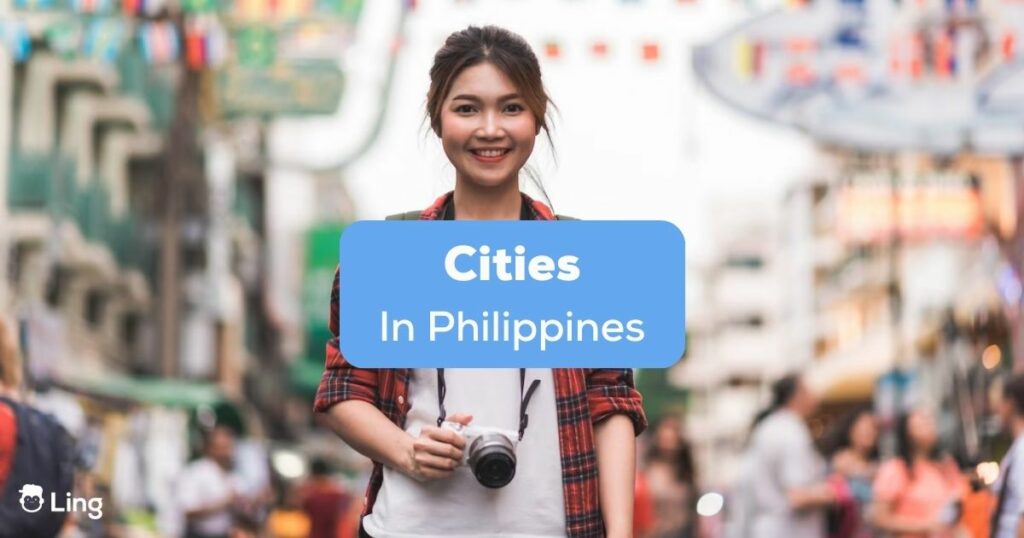Language learning is not just about textbooks and classrooms. Picture yourself talking with locals, saying ‘kamusta’ (how are you) in the busy streets of Manila.
That’s the thrill of learning in the real world – and it’s a thrill that awaits you in the Philippines.
In the Philippines, linguistic diversity is the norm. Tagalog language in Manila, Cebuano in Cebu—each city is a unique language scene.
Want to know more? Stick with us. We’re about to reveal the best cities in Philippines for language learners.
Manila: The Capital City
Our first stop is Manila. This bustling capital of the Philippines is a hub where history meets language. Let’s peel back the layers of Manila.
Overview And Official Languages
Fondly called the ‘Pearl of the Orient,’ Manila hums with energy.
Day or night, it’s a lively mix of chatter and activity.
The local lingo? That’s Tagalog, also known as Filipino.
Listen out for locals greeting each other with ‘Magandang umaga!’ (Good morning!).
And yes, English pops up a lot. It’s widely spoken here.
Language Learning Opportunities In Manila
As for learning the local language in Manila, opportunities abound.
Locals are often happy to chat and share their knowledge.
Universities like Santo Tomas and De La Salle run Tagalog classes.
Plus, some tours combine city sights with language practice.

Quezon City: The Chartered City
Next, we head to Quezon City. Named after former President Manuel L. Quezon. It’s a populous city with a story. And yes, another spot for language learning.
Overview And Official Languages
Known as QC, this city was the former capital.
It’s a lively spot where you can hear pure Tagalog.
Listen out for local sayings like ‘Mabuhay!’ (Long live!) and ‘Salamat!’ (Thank you!).
English is a common language here, so you won’t get lost in translation.
Language Learning Opportunities In Quezon City
And the language learning scene in QC? It’s rich.
You’ll find places like Ateneo de Manila University offering Filipino courses.
Meetups in cafes are common, too.
Even chatting with a street vendor while buying ‘bibingka’ (rice cake) could turn into a Tagalog chat session.
Cebu City: The Queen City Of The South
Now we’re off to Cebu City, a place of sun, sand, and a rich linguistic scene.
It’s known as the Queen City of the South and a treasure trove for language learners.
Overview And Local Language: Cebuano
Cebu City is a vibrant mix of city life and beachside relaxation.
The language here? Cebuano.
Instead of the Tagalog ‘Salamat!’ (Thank you!), locals here would say, ‘Salamat kaayo!’.
English is also a common language, keeping you in the conversation loop.
Language Learning Opportunities In Cebu City
If you’re eager to learn Cebuano, you’re in luck here.
Language programs are offered at places like the University of San Carlos, and there are numerous informal language exchange opportunities.
Every ‘Kumusta ka?’ (How are you?) you ask is a part of your language journey.
Davao City: The Crown Jewel Of Mindanao
Next, we’re southbound to Davao City. Known as the Crown Jewel of Mindanao, this large city in the Philippines is a melting pot of languages and cultures.
Overview And Local Language: Cebuano And Tagalog
In Davao City, culture and language intertwine.
Here, you’ll find locals mixing Cebuano and Tagalog.
Instead of the usual ‘Oo’ for yes in Tagalog, you might hear ‘Oo, tinuod gyud’ in Cebuano.
English is also in the mix, bridging any language gaps.
Language Learning Opportunities In Davao City
If you’re keen on learning Cebuano or Tagalog, Davao City is a good starting point.
Institutions like Ateneo de Davao University offer language programs.
Also, chatting with locals or joining in cultural activities could boost your learning.
So, every ‘Unsa’y pangalan nimo?’ (What’s your name?) in Cebuano brings you closer to fluency.

Zamboanga City: Asia’s Latin City
Let’s venture to another unique destination, Zamboanga City.
It’s not just any city. It’s also known as Asia’s Latin City due to its distinct linguistic flavor.
Overview And Unique Language: Chavacano
Zamboanga City, a blend of Filipino traditions and modernity, boasts a unique feature: the Chavacano language, a Spanish-based Creole.
You’d experience a linguistic twist here as ‘Ano ang pangalan mo?’ (What is your name?) in Tagalog would be ‘Cosa ta llama tu?’ in Chavacano.
And don’t fret. English isn’t a stranger here, ensuring everyone can understand each other.
Language Learning Opportunities In Zamboanga City
Is Chavacano on your learning list? Zamboanga City presents language learning opportunities, with universities like Ateneo de Zamboanga offering language courses.
The learning journey isn’t just confined to textbooks here, though.
You could learn while you chat with locals or participate in cultural festivals.
Each time you say, ‘De donde tu?’ (Where are you from?) in Chavacano, you’re one step closer to becoming fluent.
Local Governance And Language Policy In The Philippines
Let’s take a side trip and discuss the backstage heroes: city governments and officials.
They silently set the stage for linguistic diversity in cities in Philippines.
The Role Of City Governments In Language Learning Opportunities
City governments, far from just running the daily grind, throw their weight behind language preservation.
How do they do this?
Well, they pump resources into schools that offer local language courses, and they’re the main proponents of cultural fiestas in the Philippines that provide a platform for languages to shine.
Take the Kadayawan Festival in Davao City.
Here, the city government ensures Cebuano and Tagalog are well represented, giving language learners a real-life language immersion experience.
Local Government Code And Its Impact On Language Policy
The Local Government Code is an unassuming piece of legislation that gives city officials the authority to manage local affairs, including education.
This freedom allows officials in highly urbanized cities like Cebu and Davao to craft local language policies, creating a welcoming environment for language learners.
The result?
Language diversity not only thrives but also receives the spotlight it deserves, thanks to the dedication and support of local governance.
Explore The Cities In Philippines With Ling!
You’ve got a taste of the cities in Philippines’ vibrant language scene, and now it’s time to step into the fray yourself. Don’t fret, though! You’re not alone. The Ling app has your back.
The Ling app is a handy language-learning app that can guide you through 60+ languages.
Picture a friend who’s always there to practice the language with, whether you’re strolling Manila or sitting at home; that’s Ling.
So, why wait? Turn your language adventure in the Philippines into something special with Ling.
Get it from Google Play and App Store now!



































































